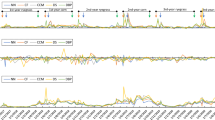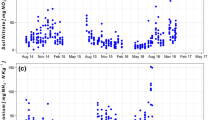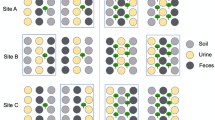Abstract
The production of beef and milk has a significant impact on climate change, as these activities are responsible for a large proportion of the greenhouse gases emitted in agriculture. We used the static closed chamber technique to measure the rate of CH4-C, N2O-N and CO2-C emissions from pastures (102 days) and bovine excretions (27 days) in an intensive pasture monoculture (PM) and an intensive silvopastoral system (ISS) in the Cauca Valley of Colombia. Mean soil CO2-C (mg m2 h−1), CH4-C and N2O-N emissions (μg m−2 h−1) were 236.7 versus 113.4; 46.7 versus 1.01 and 344.7 versus 40.1 for the PM and ISS, respectively. The accumulated flows for PM and ISS during the evaluation period were 751.6 and 424.3; 4.39 and − 0.41; and 12.75 and 1.55 (kg ha−1) for CO2-C, CH4-C and N2O-N, respectively. Regarding manure, the PM had lower CO2-C and CH4-C emissions (498.6 vs. 981.2 mg m−2 h−1, and 1.9 vs. 4.7 μg m2 h−1; p > 0.05), and higher N2O-N emissions (2967.3 vs. 1179.8 μg m−2 h−1; p = 0.02) than the ISS, respectively. For the urine patches, the ISS emitted only 47.9, 2.2 and 11.6% of the CO2-C, CH4-C and N2O-N emissions observed in the PM, respectively. Moreover, comparing both systems with a forest, CH4-C and N2O-N emissions from the ISS were not different (p > 0.05), but the PM presented higher emissions for the three gases (p < 0.0001). The emissions reported in the present study differ from the emission factors suggested by the IPCC and other authors for manure and urine. PM presented higher N losses than the ISS from both manure (1.77 vs. 1.37%) and urine (3.47 vs. 0.3%) (p < 0.05). The ISS might contribute to the reduction of GHG emissions from grasslands in contrast to traditional grazing systems, despite the high stocking rates and legume densities, producing emissions similar to those of a forest.


Similar content being viewed by others
References
Allen AG, Jarvis SC, Headon DM (1996) Nitrous oxide emissions from soils due to inputs of nitrogen from excreta return by livestock on grazed grassland in the UK. Soil Biol Biochem 28:597–607
Alves BJ, Smith R, Flores KA, Carodoso RA, Olivera AS, Jantalia WRD, Urquiaga PC, Boddey RM (2012) Selection of the most suitable sampling time for static chambers for the estimation of daily mean N2O flux from soils. Soil Biol Biochem 46:129–135
Berger L (2011) Emisiones de Óxido nitroso producidas por la actividad ganadera en el Uruguay en condiciones de pastoreo. Informe de pasantía, Facultad de Ciencias, Universidad de la República, Montevideo
Bridgham SD, Cadillo-Quiroz H, Keller JK, Zhuang Q (2013) Methane emissions from wetlands: biogeochemical, microbial, and modeling perspectives from local to global scales. Glob Chang Biol 19:1325–1346
Bueno L, Camargo JC (2015) Edaphic nitrogen and nodulation of Leucaena leucocephala (Lam.) de Wit in silvopastoral systems. Acta Agron 4(4):349–354
Burchill W, Li D, Lanigan GJ, Williams M, Humphreys J (2014) Inter-annual variation in nitrous oxide emissions from perennial ryegrass/white clover grassland used for dairy production. Glob Chang Biol 20(10):3137–3146
Burt R (2004) Soil survey laboratory methods manual version 4. USDA-NRCS, Nebraska
Calle Z, Murgueitio E, Chará J (2012) Integrating forestry, sustainable cattle-ranching and landscape restoration. Unasylva 63:31–40
Calle Z, Murgueitio E, Chará J, Molina CH, Zuluaga AF, Calle A (2013) A strategy for scaling up intensive silvopastoral systems in Colombia. Sustain For 32:677–693
Cardenas LM, Chadwick D, Scholefield D, Fychan R, Marley CL, Jones R, Bol R, Well R, Vallejo A (2007) The effect of diet manipulation on nitrous oxide and methane emissions from manure application to incubated grassland soils. Atmos Environ 41:7096–7107
Chará J, Camargo JC, Calle Z, Bueno L, Murgueitio E, Arias L, Dossman M, Molina EJ (2015) Servicios ambientales de Sistemas Silvopastoriles Intensivos: mejora en propiedades del suelo y restauración ecológica. In: Montagnini F, Somarriba E, Murgueitio E, Fassola H, Eibl B (eds) Sistemas Agroforestales. Funciones productivas, socioeconómicas y ambientales. Serie Técnica Informe Técnico 402, CATIE, Turrialba, Fundación CIPAV, Cali, pp 331–347
Curry C (2009) The consumption of atmospheric methane by soil in a simulated future climate. Biogeosciences 6:2355–2367
de Figueiredo EB, Panosso AR, Reicosky DC, La Scala N (2015) Short-term CO2-C emissions from soil prior to sugarcane (Saccharum spp.) replanting in southern Brazil. GCB Bioenergy 7:316–327
de Klein CAM, Ledgard SF (2005) Nitrous oxide emissions from New Zealand agriculture—key sources and mitigation strategies. Nutr Cycl Agroecosys 72:77–85
de Klein CAM, Li Z, Sherlock RR (2004) Determination of the N2O emission factor from animal excreta or urea, following a winter application in two regions of New Zealand. Report for MAF policy. https://www.mpi.govt.nz/document-vault/2933. Accessed 20 May 2016
Forster P, Ramaswamy V, Artaxo P, Berntsen T, Betts R, Fahey DW, Haywood J, Lean J, Lowe DC, Myhre G, Nganga J, Prinn R, Raga G, Mand S, Van Dorland R (2007) Changes in atmospheric constituents and in radiative forcing. In: Solomon S, Qin D, Chen Z, Marquis N, Averyt KB, Tignor M, Miller HL (eds) Climate change 2007: the physical science basis. Contribution of Working Group I to the Fourth Assessment Report of the Intergovernmental Panel on Climate Change. Cambridge University Press, Cambridge, pp 128–234
Galbally IE, Meyer MCP, Wang Y, Smith CJ, Weeks IA (2010) Nitrous oxide emissions from a legume pasture and the influences of liming and urine addition. Agric Ecosyst Environ 136:262–272
Gerber PJ, Steinfeld H, Henderson B, Mottet A, Opio C, Dijkman J, Falcucci A, Tempio G (2013) Tackling climate change through livestock—a global assessment of emissions and mitigation opportunities. Food and Agriculture Organization of the United Nations (FAO), Rome, p 139
Harrison MT, McSweeney C, Tomkins NW, Eckard RJ (2015) Improving greenhouse gas emissions intensities of subtropical and tropical beef farming systems using Leucaena leucocephala. Agric Syst 136:138–146
Hendriks DMD, van Huissteden J, Dolman AJ, van der Molen MK (2007) The full greenhouse gas balance of an abandoned peat meadow. Biogeosciences 4:411–424
Herrero M, Henderson B, Havlik P, Thornton PK, Conant RT, Smith P, Wirsenius S, Hristov AN, Gerber P, Gill M, Butterbach-Bahl K, Valin H, Garnett T, Stehfest E (2016) Greenhouse gas mitigation potentials in the livestock sector. Nat Clim Chang 6:452–461
Holdridge LR (1967) Life zone ecology. Tropical SCIENCE Centre, San Jose
Hristov AN, Oh J, Lee C, Meinen R, Montes F, Ott T, Firkins J, Rotz A, Dell C, Adesogan A, Yang W, Tricarico J, Kebreab E, Waghorn G, Dijkstra J, Oosting S (2013) Animal production and health paper No. 177. In: Gerber PJ, Henderson B, Makkar HP (eds) Mitigation of greenhouse gas emissions in livestock production—a review of technical options for non-CO2 emissions. FAO, Rome
Hu H-W, Chen D, He J-Z (2015) Microbial regulation of terrestrial nitrous oxide formation: understanding the biological pathways for prediction of emission rates. FEMS Microbiol Rev 39:729–749
Ibrahim M, Guerra L, Casasola F, Neely N (2010) Importance of silvopastoral systems for mitigation of climate change and harnessing of environmental benefits. In: Abberton M, Conant R, Batello C (eds) Grassland carbon sequestration: management, policy and economics. Proceedings of the workshop on the role of grassland carbon sequestration in the mitigation of climate change. Integrated Crop Management, vol 11. FAO, Roma, Italy, pp 189–196
Instituto Colombiano de Normas Técnicas y Certificación (ICONTEC) (1999) NTC 4657. Alimento para animales. Determinación del contenido de nitrógeno y cálculo del contenido de proteína cruda. Método Kjeldahl. Bogotá
Instituto Colombiano de Normas Técnicas y Certificación (ICONTEC) (2005) NTC 5350. Calidad del suelo. Determinación del Fósforo disponible. Instituto Colombiano de Normas Técnicas y Certificación. Bogotá
Instituto Colombiano de Normas Técnicas y Certificación (ICONTEC) (2006) NTC 5402. Calidad del suelo. Determinación del Azufre. Instituto Colombiano de Normas Técnicas y Certificación. Bogotá
Instituto Colombiano de Normas Técnicas y Certificación (ICONTEC) (2008a) NTC 5264. Calidad del suelo. Determinación del pH en suelos. Instituto Colombiano de Normas Técnicas y Certificación. Bogotá
Instituto Colombiano de Normas Técnicas y Certificación (ICONTEC) (2008b) NTC 5403. Calidad del suelo. Determinación del Carbono Orgánico. Instituto Colombiano de Normas Técnicas y Certificación. Bogotá
Instituto Colombiano de Normas Técnicas y Certificación (ICONTEC) (2008c) NTC 5349. Determinación de las bases intercambiables: los cationes Calcio, Magnesio, Sodio y Potacio. Método de extracción con Acetato de Amonio 1 N y pH 7. Instituto Colombiano de Normas Técnicas y Certificación. Bogotá
Instituto Geográfico Agustín Codazzi (IGAC) (2006) Métodos analíticos del laboratorio de suelos IGAC Subdirección de Agrología. VI Edición, Bogotá
IPCC (Intergovernmental Panel on Climate Change) (2006) 2006 IPCC Guideline for National Greenhouse Inventories. Intergovernmental Panel on Climate Change IPCC, France, Paris (IPCC/OECD/IEA)
Kim DS, Kim JC (2002) Soil nitric and nitrous oxide emissions from agricultural and tidal flat fields in southwestern Korea. J Environ Eng Sci 1:359–369
Korir D, Goopy J, Gachuiri C, Butterbach-Bahl K (2015) Supplementation with Calliandra calothyrsus improves N retention in cattle fed low protein diets. Anim Prod Sci 5:619–626
Kumar BM, George SJ, Jamaludheen V, Suresh TK (1998) Comparison of biomass production, tree allometry and nutrient use efficiency of multipurpose trees grown in woodlot and silvopastoral experiments in Kerala, India. For Ecol Manag 112:145–163
Lai DYF (2009) Methane dynamics in northern peatlands: a review. Pedosphere 19:409–421
Lambie SM, Schipper LA, Balks MR, Baisden WT (2012) Solubilisation of soil carbon following treatment with cow urine under laboratory conditions. Soil Res 50(1):50–57
Lang M, Cai ZC, Chang SX (2011) Effects of land use type and incubation temperatura on greenhouse gas emissions from Chinese and Canadian Soils. J Soils Sediments 11(1):15–24
Laville P, Lehuger S, Loubet B, Chaumartin F, Cellier P (2011) Effect of management, climate and soil conditions on N2O and NO emissions from an arable crop rotation using high temporal resolution measurements. Agric For Meteorol 15:1228–12240
Li YY, Dong SK, Liu S, Zhou H, Gao Q, Cao G, Wang X, Su X, Zhang Y, Tang L, Zhao H, Wu X (2015) Seasonal changes of CO2, CH4 and N2O fluxes in different types of alpine grassland in the Qinghai-Tibetan Plateau of China. Soil Biol Biochem 80:306–314
Linquist B, Van Groenigen KJ, Adviento-Borbe MA, Pittelkow C, Van Kessel C (2012) An agronomic assessment of greenhouse gas emissions from major cereal crops. Glob Chang Biol 18:194–209
Luo J, Lindsey SB, Ledgard SF (2008) Nitrous oxide emissions from animal urine application on a New Zealand pasture. Biol Fertil Soils 44:463–470
Luo J, de Klein CAM, Ledgard SF, Saggar S (2010) Management options to reduce nitrous oxide emissions from intensively grazed pastures: a review. Agric Ecosyst Environ 136:282–291
Medvedeff CA, Bridgham SD, Pfeifer-Meister L, Keller JK (2015) Can Sphagnum leachate chemistry explain differences in anaerobic decomposition in peatlands? Soil Biol Biochem 86:34–41
Meng Q, Sun Y, Zhao J, Zhou L, Ma X, Zhou M, Gao W, Wang G (2014) Distribution of carbon and nitrogen in water-stable aggregates and soil stability under long-term manure application in solonetzic soils of the Songnen plain, northeast China. J Soils Sediments 14(6):1041–1049
Merbold L, Steinlin C, Hagedorn F (2013) Winter greenhouse gas emissions (CO2, CH4 and N2O) from a sub-alpine grassland. Biogeosci Discuss 10:401–445
Minamikawa K, Tokida T, Sudo S, Padre A, Yagi K (2015) Guidelines for measuring CH4 and N2O emissions from rice paddies by a manually operated closed chamber method. National Institute for Agro-Environmental Sciences, Tsukuba
Molina IC, Angarita EA, Mayorga OL, Chará J, Barahona R (2016) Effect of Leucaena leucocephala on methane production of Lucerna heifers fed a diet based on Cynodon plectostachyus. Livest Sci 185:24–29
Muñoz C, Saggar S, Berben P, Giltrap D, Jha N (2011) Influence of waiting time after insertion of base chamber into soil on produced greenhouse gas fluxes. Chil J Agric Res 71(4):610–614
Murgueitio E, Chará JD, Barahona R, Cuartas CA, Naranjo JF (2014) Intensive silvopastoral systems (ISPS), mitigation and adaptation tool to climate change. Trop Subtrop Agroecosyst 17(3):501–507
Murgueitio E, Barahona R, Chará J, Flores M, Mauricio RM, Molina JJ (2015a) The intensive silvopastoral systems in Latin America: sustainable alternative to face climatic change in animal husbandry. Cuban J Agric Sci 49(4):541–554
Murgueitio E, Flores M, Calle Z, Chará J, Barahona R, Molina CH, Uribe F (2015b) Productividad en Sistemas silvopastoriles intensivos en América Latina. In: Montangnini F, Somattiba E, Murgueitio E, Fasola H, Eibl B (eds) Sistemas agroforestales. Funciones productivas, socioeconómicas y ambientales. CIPAV, Cali, pp 59–101
Nair PKR, Kumar BM, Nair VD (2009) Agroforestry as a strategy for carbon sequestration. J Plant Nutr Soil Sci 172:10–23
Nair PKR, Nair VD, Kumar BM, Showalter JM (2010) Carbon sequestration in agroforestry systems. Adv Agron 108:237–307
Oertel C, Matschullat J, Zurba K, Zimmermann K, Erasmi S (2016) Greenhouse gas emissions from soils—a review. Chemie der Erde –Geochemistry 76(3):327–352
Orwin KH, Bertram JE, Clough TJ, Condron LM, Sherlock RR, O’Callaghan M, Ray J, Baird DB (2010) Impact of bovine urine deposition on soil microbial activity, biomass, and community structure. Appl Soil Ecol 44:89–100
Pastrana I, Reza S, Espinosa M, Suárez E, Díaz E (2011) Efecto de la fertilización nitrogenada en la dinámica del óxido nitroso y metano en Brachiaria humidicola (Rendle) Schweickerdt. Corpoica Cienc Tecnol Agropecu 12(2):134–142
Rafique R, Hennessy D, Kiely G (2011) Nitrous oxide emission from grazed grassland under different management systems. Ecosystems 14:563–582
Reay D, Grace J (2007) Carbon dioxide: importance, sources and sinks. In: Reay D et al (eds) Greenhouse gas sinks. CAB International, Wallingford, pp 1–10
Rivera J, Chará J, Barahona R (2016) Análisis de ciclo de vida para la producción de leche bovina en un sistema silvopastoril intensivo y un sistema convencional en Colombia. Trop Subtrop Agroecosyst 19:237–251
Rivera J, Molina I, Chará J, Murgueitio E, Barahona R (2017) Intensive silvopastoral systems with Leucaena leucocephala (Lam) de Wit: productive alternative in the tropic in view of climate change. Pastos y Forrajes 40:159–170
Saggar S, Andrew RM, Tate KR, Hedley CB, Rodda NJ, Townsend JA (2004) Modelling nitrous oxide emissions from dairy grazed pastures. Nutr Cycl Agroecosys 68:243–255
Senbayram M, Chen R, Budai A, Bakken L, Dittert K, Zavattaro L, Grignani C, Acutis M, Rochette P (2012) N2O emission and the N2O/(N2O + N2) product ratio of denitrification as controlled by available carbon substrates and nitrate concentrations. Agric Ecosyst Environ 147:4–12
Sherlock RR, de Klein CAM, Li Z (2003) Determination of the N2O and CH4 emission factor from animal excreta, following a summer application in 3 regions of New Zealand. Report for MAF policy. https://www.mpi.govt.nz/document-vault/2950. Accessed 20 May 2017
Sordi A, Dieckow J, Bayer C, Albuquerque MA, Piva JT, Zanatta JA, Tomazi M, Rosa CM, Moraes A (2014) Nitrous oxide emission factors for urine and dung patches in a subtropical Brazilian pastureland. Agric Ecosyst Environ 90:94–103
Statistical Analysis System (SAS) (2001) SAS/STAT user’s guide, Software Versión 9.1. SAS institute Inc, Cary
Uchida Y, Clough TJ, Kelliher FM, Hunt JM, Sherlock RR (2011) Effects of bovine urine, plants and temperature on N2O and CO2 emissions from a sub-tropical soil. Plant Soil 345:171–186
Valadares RFD, Broderick GA, Valadares SC, Clayton MK (1999) Effect of replacing alfalfa silage with high moisture corn on ruminal protein synthesis estimated from excretion of total purine derivatives. J Dairy Sci 82:2686–2696
Van der Weerden TJ, Luo JF, de Klein CAM, Hoogendoorn CJ, Littlejohn RP, Rys GJ (2011) Disaggregating nitrous oxide emission factors for ruminant urine and dung deposited onto pastoral soils. Agric Ecosyst Environ 141(3–4):426–436
Van der Weerden TJ, Manderson A, Kelliher FM, de Klein CAM (2014) Spatial and temporal nitrous oxide emissions from dairy cattle urine deposited onto grazed pastures across New Zealand based on soil water balance modelling. Agric Ecosyst Environ 189:92–100
Van Groenigen JW, Kuikman PJ, de Groot WJM, Velthof GL (2005) Nitrous oxide emissions from urine-treated soil as influenced by urine composition and soil physical conditions. Soil Biol Biochem 37:463–473
Wachendorf C, Lampe C, Taube F, Dittert K (2008) Nitrous oxide emissions and dynamics of soil nitrogen under 15N-labeled cow urine and dung patches on a sandy grassland soil. J Plant Nutr Soil Sci 171:171–180
Whitehead DC (1995) Grassland nitrogen. CAB International, Wallingford
Williams DL, Ineson P, Coward PA (1999) Temporal variations in nitrous oxide fluxes from urine-affected grassland. Soil Biol Biochem 31:779–788
Wu X, Yao Z, Bruggemann N, Shen ZY, Wolf B, Dannenmann M, Zheng X, Butterbach-Bahl K (2010) Effects of soil moisture and temperature on CO2 and CH4 soil e atmosphere exchange of various land use/cover types in a semiearid grassland in Inner Mongolia, China. Soil Biol Biochem 42:773–787
Ye R, Doane TA, Morris J, Horwath WR (2015) The effect of rice straw on the priming of soil organic matter and methane production in peat soils. Soil Biol Biochem 81:98–107
Acknowledgments
The authors wish to acknowledge the financial support received from the Colombian Ministry of Agriculture and Rural Development and the International Centre for Tropical Agriculture for the project “Análisis Integral de sistemas productivos en Colombia para la adaptación al cambio climático” and from COLCIENCIAS for the project “Uso de nitrógeno por ganado bovino criollo colombiano bajo sistemas silvopastoriles intensivos con Leucaena leucocephala en condiciones de bosque seco tropical (561-2011)”. Thanks also to El Hatico and Trejitos farm owners for the permission to carry out this study, the provision of data and the collaboration during the field work.
Author information
Authors and Affiliations
Corresponding author
Rights and permissions
About this article
Cite this article
Rivera, J.E., Chará, J. & Barahona, R. CH4, CO2 and N2O emissions from grasslands and bovine excreta in two intensive tropical dairy production systems. Agroforest Syst 93, 915–928 (2019). https://doi.org/10.1007/s10457-018-0187-9
Received:
Accepted:
Published:
Issue Date:
DOI: https://doi.org/10.1007/s10457-018-0187-9




